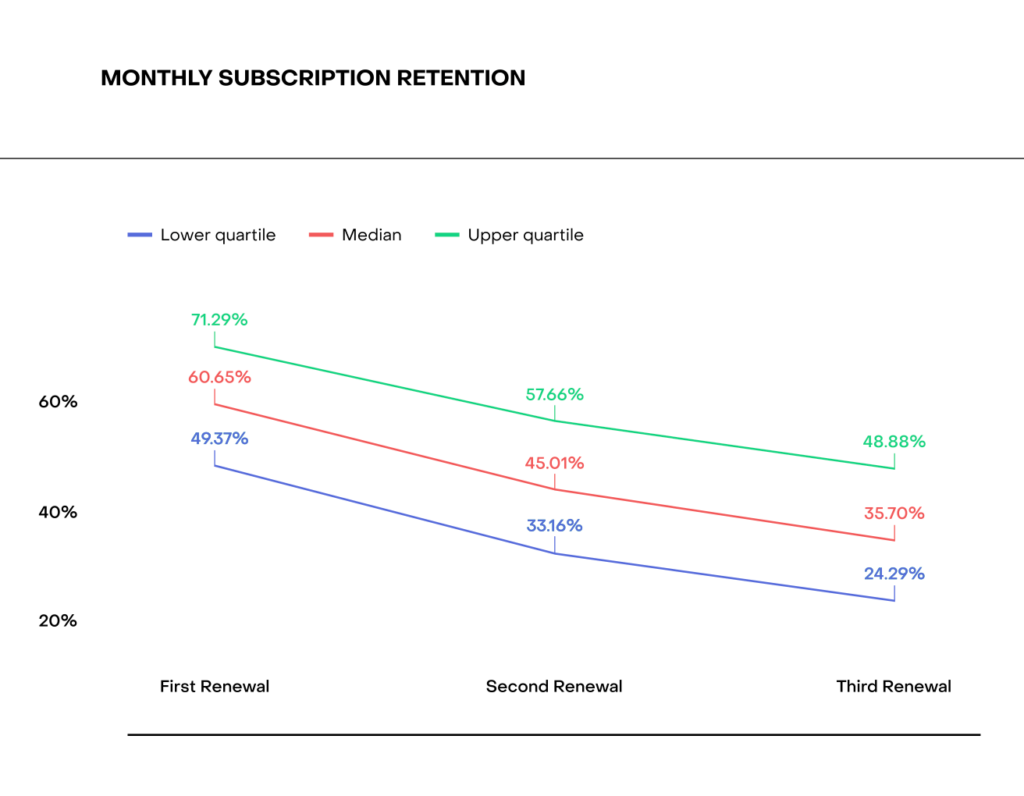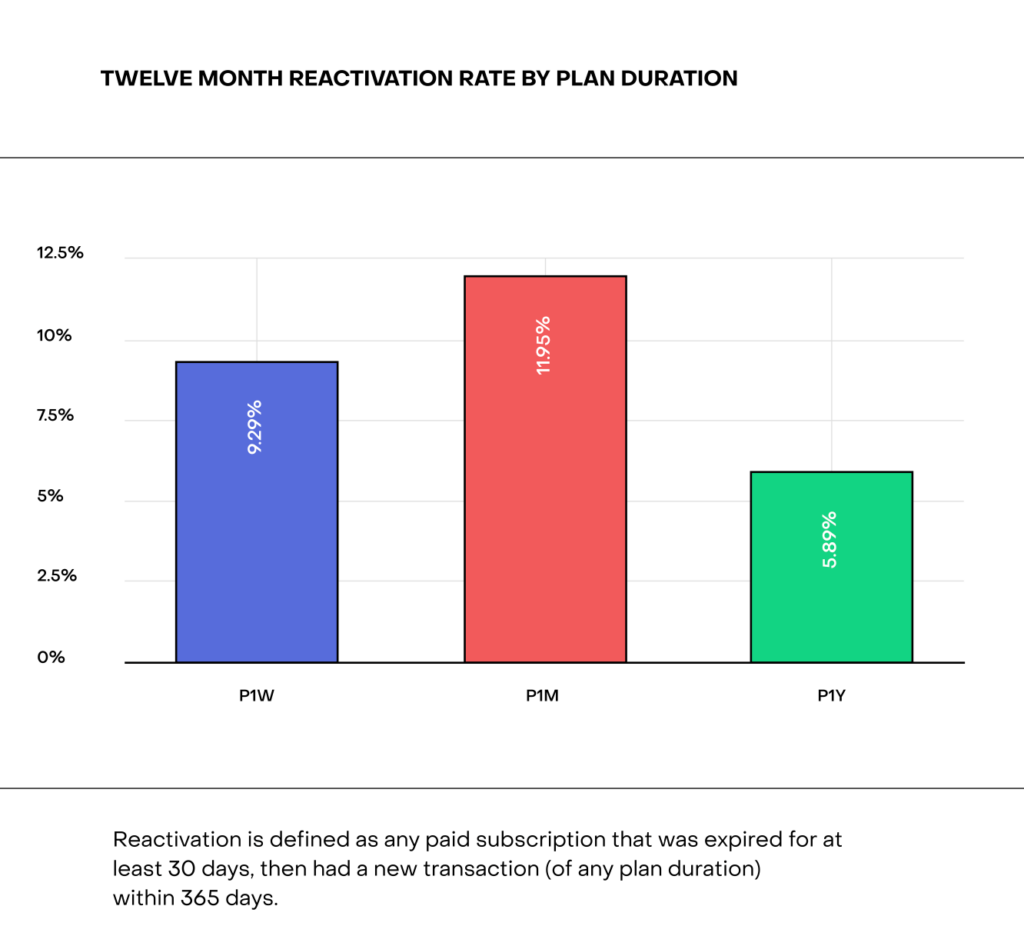Retargeting ads: An overlooked tactic for winback & reactivation
A relatively easy but overlooked way to win back and reactivate churned users.

Nobody likes churn. You work hard to attract users, nurture them, and convert them while (hopefully) providing enough value that they stick around as loyal customers for a long time. You invest a lot in them. So when they leave, it can feel like a shot to the heart. But, you don’t give up there!
If you were in love – truly in love – and you made a mistake that caused your significant other to say “I just need some space”, would you turn and walk away, accepting the breakup? Or would you get yourself a boombox and stand outside their window blaring Peter Gabriel to convince them that you were meant to be together? Well, retargeting can be your boombox: an amplifier to remind customers of everything that you bring to the table, compelling them to come back and give you another chance.

The opportunity for retargeting churned customers
Reactivation is a huge opportunity for app developers that want to maximize growth — particularly for apps with a higher degree of product-market fit. According to our 2024 State of Subscription Apps Report, even best-in-class subscription apps can expect 29% of new monthly subscriptions to churn before their first renewal and roughly 50% of monthly subscriptions to churn before a third renewal. That’s half of all new subscribers churning after 90 days.
But, just because a customer cancels their subscription, does not mean that they’re gone for good. In fact, we found that 12% of churned monthly subscribers are likely to reactivate within a year. Shortening the time from churn to reactivation or increasing the percentage of customers that reactivate by just a small amount could have a massive impact on revenue.


In order to effectively win these customers back, it’s helpful to segment them to understand why they disengaged, develop personalized offers to address their concerns, remind them what they’re missing, and make sure they understand the full value of your subscription. A relatively easy, but often overlooked way to do this at scale is via programmatic retargeting ads.
What are retargeting ads?
If you’re an app marketer, you’re probably familiar with retargeting. Even if you’re not an app marketer, you’ve definitely been retargeted.
You visit a website to look at a product, maybe you add it to your shopping cart, but you don’t buy it. All of the sudden, you’re seeing the product everywhere — on social media, email, even your TV. The ads are relentlessly reminding you of the product you viewed, sometimes throwing in special offers, trying to convince you to return and make the purchase.
This happens because the advertiser is syncing a (programmatically generated) audience of users that have taken a specific action to their ad networks. This happens either through a cookie, or by connecting a dynamic list. Ask your User Acquisition team — you’re probably using some form of retargeting there today. It can admittedly be annoying (if left unchecked by the marketer) but it’s extremely effective.
Not only is the audience targeted very specific and more likely to click and convert, they’re also — by definition – smaller than the ‘top of funnel’, broad advertising campaigns you run. Together, this means that retargeting campaigns can run with relatively limited budgets, at very attractive cost per click or conversion.
How can retargeting help with reactivation?
After talking with several app growth teams, we have been surprised to find that retargeting is often overlooked as a tactic to support winback & reactivation. Typically, User Acquisition “owns” the ad platforms like Google Ads & Meta Ads, which could mean that their counterparts in the lifecycle or retention team might lack access to the retargeting capabilities that exist within these tools.
A missed opportunity, because retargeting makes for a great addition to your reactivation playbook. For that use case, in particular, they stand out for:
- Cost-effectiveness: According to AppsFlyer, retargeting users who have yet to convert generates a 5X higher ROI than other UA tactics. For reactivation, the ROI should be even greater because you’re targeting people that have already proven a willingness to pay for your service. Not to mention, a large chunk of churn is involuntary! Which means that many users might actively want to pay you. They just need to know how.
- Measurability: When you launch a retargeting campaign, your ads are always running, accumulating impressions and clicks almost immediately. The more your ads show, the more data you collect on engagement, conversion, and reactivation. The great thing is, you can act on this data immediately while your campaigns run. Unlike push notifications or email, you don’t have to wait until your next send to make changes. You can iterate and A/B test creative, messaging, formats and audience segments throughout the lifetime of your campaign.
- Cross-platform targeting: unlike other 1:1 reactivation tactics (push notifications, email, and SMS) that are limited to reaching an audience on a single device or in a contained inbox, retargeting ads come in many formats and can reach users across devices (web, mobile, and even connected TV) – expanding reach and access to your target audience. Bonus: if you offer web subscriptions for your app, you can use web-based ad placements to direct your audience to reactivate there, bolstering ROI by bypassing app store fees in the process!
Common retargeting channels & ad platforms:
Unlike contextual ad targeting, retargeting campaigns typically focus primarily on the audience rather than ad placement or location. Most major ad networks support retargeting, whether via integrations, cookie-based targeting, or custom list uploads. Getting started with the below networks should provide coverage for most audiences you’ll want to target.
- Meta Ads: Meta Ads (including both Facebook and Instagram) provides not only robust targeting capabilities but also a variety of ad formats, going beyond the traditional “banner ad” to include things like carousels, stories, and interactive playable app previews. The Facebook Ads SDK allows you to track in-app events across iOS and Android and create custom audiences based on actions that users take in your app.
- Google Display Network: The Google Display Network is one of the largest in the world – reaching over 35 million websites and apps, including Google-owned properties like YouTube and Gmail, making it one of the widest-reaching networks for online advertising. Google also offers Dynamic Remarketing for Apps which allows for hyper-personalization based on in-app actions. Similar to Meta, Google Ads allows you to create custom audiences based on in-app events using either Firebase or a third party SDK.
- Twitter / X: Twitter – err, X – allows for the creation of App Activity Audiences, provided you integrate with your Mobile Measurement Partner. While the creative formats on X are limited, they emphasize brevity and can provide an excellent way to test quick, concise messaging while reaching users primarily on mobile.
Creating & managing retargeting audiences:
No matter the ad platform, you’ll need a way to create and manage the audience segments that you want to target. You’ll notice each of the above platforms offers an SDK that allows you to create audiences based on in-app events – while these SDKs are helpful, they’re not always great for identifying users who have unsubscribed from your app, especially if they churn due to billing issues or cancel their subscription from outside of the app (e.g. from their Apple ID account).
You could, of course, upload a .csv file containing customer emails or mobile advertising IDs, but doing this manually would require you to regularly refresh the list and could quickly result in outdated targeting. Instead, you could use RevenueCat to create custom subscriber lists and automatically schedule exports to the ad platform of your choice (or, if using Meta Ads, check out our Meta Ads Audiences integration).
For the highest match rate, we suggest setting and including the following subscriber attributes in your list:
- Email (if set)
- IDFA (apple advertising identifier)
- IDFV (apple vendor identifier)
- gpsAdId (Google advertising identifier, if using Google Ads)
- fbAnonId (Facebook Anonymous ID, if using Meta Ads)
- IP Address
- User Location
You may also refer to each ad network’s documentation for specific requirements. If using a Mobile Measurement Partner, you’ll also want to include a relevant third-party identifier.
Audience segmentation is key
Of course, you want to win back as many customers as possible, but that doesn’t mean that you should lump them all together and target them with the same offer. Instead, segmenting based on shared attributes or behaviors can help you craft a more personalized and effective campaign. This can also help you allocate budget to your highest value customers, or those that are most likely to reactivate.
Here are some ways you can think about segmenting your audiences for retargeting, before launching a campaign.
- Acquisition cohort – it’s important to understand when and how a customer was initially acquired before churning. Were they only around for 1 week – and did they have enough time to fully realize your product’s value? You may also want to consider whether a special offer was used to acquire a segment (e.g. did they make their initial purchase with a discount or promotion? If so, they may be less likely to return at full price).
- Lifetime value – similarly, you may be willing to invest a bit more to reactivate customers with high LTV. Segmenting churned users into quartiles based on LTV can help to prioritize those that have already proven to be highly profitable
- Feature utilization – segment users based on their in-app behavior. Are there certain features in your app that customers love, and if so, did any of your churned customers not use that feature? Or maybe there are some who were close to hitting a goal or milestone; consider running ads that motivate them to come back and reach that goal.
- Churn reason – Billing errors account for over 23% of churn on the app store. Many of these users don’t actually intend to cancel their subscriptions, but might carry on unnoticed if you don’t remind them. You might also capture more self-reported churn reasons at the time of cancellation – pricing, missing features, or competitor offers – that could also guide your winback messaging.
- Demographics – does your app cater to certain age groups or genders? If so, you’d probably want to consider focusing your retargeting on those key characteristics in order to maximize the likelihood that they return.
- Localization – this is a big one. Purchasing power, pricing expectations, and market conditions vary widely across countries & regions. Segmenting churned users geographically can help you test local offers, while also providing customers with the best possible value for your product.
- (Bonus) At-risk / Preventative segments – there might also be signals that could hint at users potentially gearing up to churn soon. For instance, if they haven’t opened your app in while. It’s not a bad idea to proactively target these customers before they churn in an effort to “talk them off the ledge”. Worst case, you’re reminding a happy customer of your value.
Key takeaways
- Churn is inevitable but not final: Even best-in-class subscription apps face significant churn rates, with up to 50% of monthly subscribers churning before their third renewal. However, 12% of churned monthly subscribers are likely to reactivate within a year.
- Retargeting as a winback strategy: Retargeting ads can serve as an effective tool to re-engage churned users, reminding them of the value they once saw in your app and encouraging them to return.
- Cost-effectiveness of retargeting: Retargeting campaigns tend to have a high ROI, especially for reactivation, since they target users who have already shown a willingness to pay for your service.
- Measurability and flexibility: Retargeting allows for real-time data collection and immediate adjustments to campaigns, offering an advantage over other reactivation methods like email or push notifications.
- Cross-platform reach: Retargeting ads can reach users across various devices and platforms, providing a broader reach compared to other 1:1 reactivation tactics.
- Segmentation is crucial: Effective retargeting requires segmenting your audience based on attributes like acquisition cohort, lifetime value, feature utilization, churn reason, demographics, and location to craft personalized and impactful campaigns.
- Common retargeting channels: Major ad networks like Meta Ads, Google Display Network, and Twitter/X offer robust retargeting capabilities, allowing you to reach your audience effectively across different platforms.
- Managing retargeting audiences: Utilize tools like RevenueCat to create and manage custom subscriber lists for retargeting, ensuring accurate and up-to-date targeting.
📚 Further reading: Beyond retargeting, there are more ways to win-back cancelled users. Find out how.
You might also like
- Blog post
How to increase your annual subscription uptake
Inspiration from Runna, Mino, Freedom and more
- Blog post
“I don’t start working on something unless I’m confident it’s something I care about” — Christian Selig, Apollo
Exploring Apollo’s journey: from its rise to becoming Reddit’s top app to its shutdown, and what’s next for creator Christian Selig.
- Blog post
The essential guide to TikTok Ads for subscription apps
Everything you would possibly need to know to unlock growth for your subscription app using TikTok Ads.

